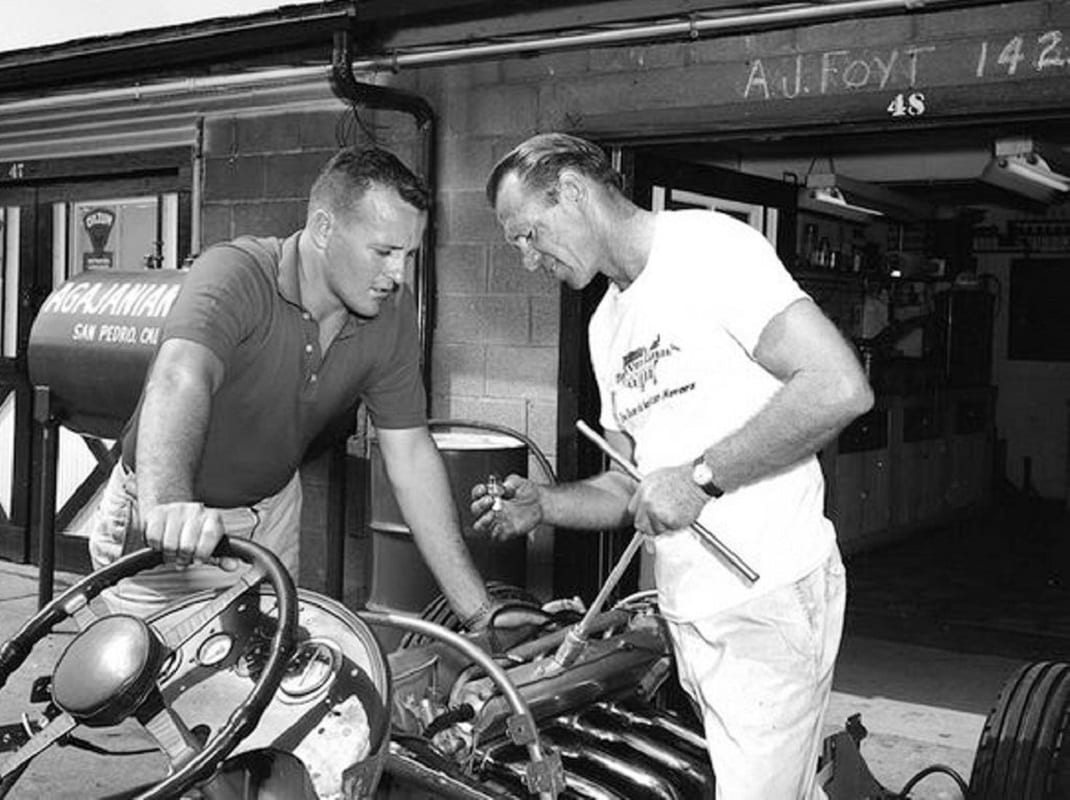During an era when the chief mechanic was a fabricator, engine builder, designer, race strategist and team manager, Clint Brawner stood above the rest.
He could fix anything. His philosophy was simple: “If a man made it, a man could fix it.”
When A.J. Watson, Jack Beckley or George Bignotti had something beyond their ability to fabricate or repair, they gave it to Brawner.
A Phoenix, Ariz., farm kid, Brawner repaired and maintained the family’s farm equipment. That evolved to working on cars and eventually race cars. By 1950, he’d made his first appearance on an Indianapolis 500 crew and established a reputation for making temperamental race cars fast and reliable.
His big break came in 1953 when Al Dean formed a championship car team and recruited Brawner to run it. That relationship lasted until Dean’s death in 1967.
Future Indy 500 winner Bob Sweikert drove the Dean Van Lines Kuzma, winning the inaugural Hoosier Hundred. But another driver attracted Brawner’s eye for new talent — Jimmy Bryan.
From 1954 to ’57, Bryan won 19 champ car races for Brawner, including three consecutive Hoosier Hundreds and three national championships. At the end of 1957, Bryan left.
The Indianapolis 500 eluded Brawner in a baffling way. Sweikert won the 500 the year after leaving Brawner’s care, as did Bryan. A.J. Foyt won Indy two years after departing Brawner — the same year, 1961, that Brawner’s driver, Eddie Sachs, should have.
Within three laps of the checkered flag, Sachs unexpectedly pitted from the lead with worn tires. Until his death, Brawner insisted the tires could’ve gone the distance.
Sachs left the team in 1963 and a couple of bleak seasons followed as Brawner’s picks to replace him either died or were severely injured in sprint cars. Those tragedies, however, opened the door for the driver who delivered unprecedented success — Mario Andretti.
Brawner built a new car for Andretti in 1965. It was his first rear-engine effort, and he dubbed it the Hawk. Andretti finished third and claimed rookie-of-the-year honors at Indianapolis.
When Andretti won the national championship, more success, including a 500 victory, appeared certain. The other successes came, but Andretti evidently inherited Brawner’s 500 curse.
During the next three 500s, he captured the pole twice but only ran a mere 87 laps. The announcer’s call, “Mario is slowing down,” became a part of speedway lore.
Upon Al Dean’s death, flamboyant Andy Granatelli became team owner and commissioned Lotus’ Colin Chapman to build state-of-the-art cars for the 1969 Indy 500. With Granatelli’s swarm of technicians and mechanics, Brawner’s role diminished, although, he retained the chief mechanic title.
Andretti loved the high-tech Lotus. It was fast. Then three days before pole day, a hub splintered. The resultant crash destroyed the car and left Andretti with second-degree facial burns.
Brawner was back in the spotlight. He rolled out the Hawk and Andretti put it in the middle of row one. However, attempting to streamline the car to enhance qualifying speed, Brawner removed the external oil cooler, intending to reinstall it for the race.
Brawner was originally given the OK for this even though USAC rules stated that a qualified car had to be raced without external changes. At the insistence of Foyt, USAC enforced the rule.
Mechanic Eamon “Chalkie” Fullalove suggested a cooler installed under the seat would conform to USAC rules and could help cool the hot-running, turbocharged Ford engine.
Brawner liked the idea and he and Chalkie installed the tank. At the green flag, Andretti jumped to the front, but within a few laps the Ford ran hot. He backed off, the temperature dropped and the race came to him.
Brawner’s low-tech Hawk, built in his garage shop and enhanced with some shade tree mechanic ingenuity, gave him, Andretti and Granatelli their first and only 500 victory.
Brawner claimed he’d retire if he won the 500, but he continued and wrenched Andretti to yet another national championship.
Brawner immersed himself in racing until the early 1980s. He died from skin cancer on Dec. 23, 1987.
